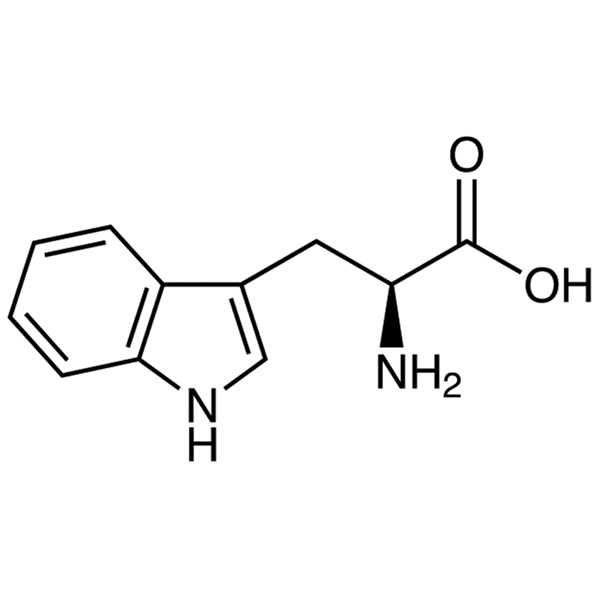L-Tryptophan CAS 73-22-3 (H-Trp-OH) Assay 98.5~101.5% High Quality
Shanghai Ruifu Chemical Co., Ltd. is the leading manufacturer and supplier of L-Tryptophan (H-Trp-OH; Trp or W) (CAS: 73-22-3) with high quality. As one of the largest amino acids suppliers in China, Ruifu Chemical supplys amino acids up to international standards, such as AJI, USP, EP, JP and FCC standards.
Ruifu Chemical can provide competitive price, excellent service, small and bulk quantities available.
If you are interested in L-Tryptophan, Please contact: alvin@ruifuchem.com
| Chemical Name | L-Tryptophan |
| Synonyms | H-Trp-OH; L-(-)-Tryptophan; (-)-Tryptophan; Tryptophan; L-Trp; Abbreviated Trp or W; (S)-(-)-2-Amino-3-(3-Indolyl)propionic Acid; L-α-Amino-3-Indolepropionic Acid; 2-Amino-3-(1H-Indol-3-yl)propanoic Acid |
| Stock Status | In Stock, Production Capacity 3000 Tons per Year |
| CAS Number | 73-22-3 |
| Molecular Formula | C11H12N2O2 |
| Molecular Weight | 204.23 |
| Melting Point | 282℃(dec.)(lit.) |
| Density | 1.34 |
| Water Solubility | Slightly Soluble in Water (11.4 g/l 25℃) |
| Solubility | Slightly Soluble in Ethanol. Very Slightly Soluble in Alcohol. Insoluble in Ether, Chloroform |
| Stability | Stable. Incompatible with Strong Acids, Strong Oxidizing Agents |
| Shelf Life | 24 Months When Properly Stored |
| COA & MSDS | Available |
| Origin of Product | Shanghai, China |
| Test Standard | AJI97, USP35, EP11.0 |
| Classification | Amino Acids and Derivatives; Pharmaceutical Intermediates |
| Brand | Ruifu Chemical |
| Items | Inspection Standards | Results |
| Appearance | White Crystals or Crystalline Powder | Conforms |
| Identification | Meets the Requirements | Conforms |
| Specific Rotation [α]20/D | -30.5° to -32.5° (C=1,H2O) | -31.5° |
| State of Solution | ≥95.0% (Transmittance) | 96.7% |
| Chloride (Cl) | ≤0.020% | <0.020% |
| Sulfate (SO4) | ≤0.020% | <0.020% |
| Ammonium (NH4) | ≤0.020% | <0.020% |
| Iron (Fe) | ≤20ppm | Conforms |
| Heavy Metals (Pb) | ≤10ppm | Conforms |
| Arsenic (As2O3) | ≤1.0ppm | Conforms |
| Other Amino Acids | Meets the Requirement | Conforms |
| Loss on Drying | ≤0.20% (at 105℃ for 3 hours) | 0.16% |
| Residue on Ignition (Sulfated) | ≤0.10% | 0.04% |
| Assay | 98.5~101.0% | 99.7% |
| pH | 5.4~6.4 (1.0g in 100ml of H2O ) | 5.8 |
| Organic Volatile Impurities | Meets the Requirement | Conforms |
| Pyrogen | Nonpyrogenic | Conforms |
| Conclusion:This Product by Inspection Accords with the Standard of AJI97, USP35 | ||
L-Tryptophan (H-Trp-OH) (CAS: 73-22-3) AJI 97 Test Method
Identification: Compare the infrared absorption spectrum of the sample with that of the standard by potassium bromide disc method.
Specific Rotation [α]20/D: Dried Sample, C=1, H2O dissolve by warming
State of Solution (Transmittance): 0.5g in 20ml of 2 mol/L HCl, spectrophotometer, 430nm, 10mm cell thickness.
Chloride (Cl): 0.7g, A-1, ref: 0.40ml of 0.01mol/L HCl
Ammonium (NH4): B-2
Sulfate (SO4): 1.2g, (1), ref: 0.50ml of 0.005mol/L H2SO4
Iron (Fe): 0.75g, (2), ref: 1.5ml of Iron Std. (0.01mg/ml)
Heavy Metals (Pb): 2.0g, (4), ref: 2.0ml of Pb Std. (0.01mg/ml)
Arsenic (As2O3): 2.0g, (1), ref: 2.0ml of As2O3 Std.
Other Amino Acids: H2O, Dissolve by warming (40℃) Test Sample: 50μg, A-6-a, control: L-Trp 0.25μg
Loss on Drying: at 105℃ for 3 hours.
Residue on Ignition (Sulfated): AJI Test 13
Assay: Dried sample, 200mg, (1), 3ml of formic acid, 50ml of glacial acetic acid, 0.1mol/L HCLO4 1ml=20.423mg C11H12N2O2
pH Test: 1.0g in 100ml of H2O
L-Tryptophan (H-Trp-OH) (CAS: 73-22-3) USP35 Test Method
DEFINITION
Tryptophan contains NLT 98.5% and NMT 101.5% of C11H12N2O2, as L-Tryptophan, calculated on the dried basis.
IDENTIFICATION
A. INFRARED ABSORPTION <197K>
ASSAY
PROCEDURE
Sample solution: Place 200 mg of Tryptophan in a 125-mL flask. Dissolve in a mixture of 3 mL of formic acid and 50 mL of glacial acetic acid.
Analysis: Titrate with 0.1 N perchloric acid VS, determining the endpoint potentiometrically. Perform a blank determination, and make any necessary correction (see Titrimetry <541>). Each mL of 0.1 N perchloric acid is equivalent to 20.42 mg of C11H12N2O2.
Acceptance criteria: 98.5%~101.5% on the dried basis
IMPURITIES
Inorganic Impurities
RESIDUEON IGNITION <281>: NMT 0.1%
CHLORIDE AND SULFATE, Chloride <221>: A 0.73-g portion shows no more chloride than corresponds to 0.50 mL of 0.020 N hydrochloric acid (0.05%). [NOTE-Gently heat the sample preparation to dissolve, if necessary.]
CHLORIDE AND SULFATE, Sulfate <221>: A 0.33-g portion shows no more sulfate than corresponds to 0.10 mL of 0.020 N sulfuric acid (0.03%). [NOTE-Gently heat the sample preparation to dissolve, if necessary.
IRON <241>: NMT 30ppm
HEAVY METALS, Method II <231>: NMT 15ppm
Organic Impurities
PROCEDURE 1
Solution A: Trifluoroacetic acid in water (1 mL/L)
Solution B: Trifluoroacetic acid in an acetonitrile and water solution (80:20) (1 mL/L trifluoroacetic acid solution)
Standard solution: 1.0 mg/L each of USP Tryptophan Related Compound A RS and USP Tryptophan Related Compound B RS in water
Sample solution: 10.0 mg/mL of tryptophan in water
System suitability solution: 1.0 mg/L of USP Tryptophan Related Compound B RS in water
Mobile phase: See the gradient table below.
| Time (min) | Solution A (%) | Solution B (%) |
| 0 | 95 | 5 |
| 2 | 95 | 5 |
| 37 | 35 | 65 |
| 42 | 0 | 100 |
| 47 | 0 | 100 |
| 50 | 95 | 5 |
| 60 | 95 | 5 |
Chromatographic system (See Chromatography <621>, System Suitability.)
Mode: LC
Detector: UV 220 nm
Column: 4.6-mm × 25-cm; 5-µm packing L1
Column temperature: 30°
Flow rate: 1 mL/min
Injection size: 20 µL
System suitability
Sample: System suitability solution
Suitability requirement
Relative standard deviation: NMT 5.0%
Analysis
Samples: Standard solution and Sample solution
Calculate the percentage of each unspecified impurity in the portion of Tryptophan taken:
Result = (rU/rS) × (CS/CU) × 100
rU = peak area of each unspecified impurity in the Sample solution
rS = peak area of tryptophan related compound B in the Standard solution
CS = concentration of USP Tryptophan Related Compound B RS in the Standard solution (µg/mL)
CU = concentration of Tryptophan in the Sample solution (µg/mL)
Acceptance criteria
Total impurities 1: NMT 0.01% of the total impurities eluting prior to the tryptophan peak
Total impurities 2: NMT 0.03% of the total impurities eluting after the tryptophan peak. [NOTE-Exclude the peak for tryptophan related compound B.]
Tryptophan related compound A: If a peak for tryptophan related compound A is observed in the Sample solution, then perform the test for Procedure 2: Limit of Tryptophan Related Compound A, below.
PROCEDURE 2: LIMIT OF TRYPTOPHAN RELATED COMPOUND A
Solution A: 18 mM monobasic sodium phosphate, filtered and degassed (pH 2.5), and acetonitrile (9:1)
Solution B: 10 mM monobasic sodium phosphate, filtered and degassed (pH 2.5), and acetonitrile (1:1)
Solution C: Acetonitrile in water (7:3)
Standard solution: 0.1 mg/L of USP Tryptophan Related Compound A RS in water
Sample solution: 10.0 mg/mL of Tryptophan in water
Mobile phase: See the gradient table below
| Time (min) | Solution A (%) | Solution B (%) | Solution C (%) |
| 0 | 100 | 0 | 0 |
| 30 | 44 | 56 | 0 |
| 30.1 | 0 | 0 | 100 |
| 45 | 0 | 0 | 100 |
| 45.1 | 100 | 0 | 0 |
| 60 | 100 | 0 | 0 |
Chromatographic system
(See Chromatography <621>, System Suitability.)
Mode: LC
Detector: UV 216 nm
Column: 3.9-mm × 15-cm; 5-µm packing L1
Column temperature: 30°
Flow rate: 1 mL/min
Injection size: 20 µL
System suitability
Sample: Standard solution
Suitability requirement
Relative standard deviation: NMT 5.0%
Analysis
Samples: Standard solution and Sample solution
Calculate the percentage of tryptophan related compound
A in the portion of Tryptophan taken:
Result = (rU/rS) × (CS/CU) × 100
rU = peak area of tryptophan related compound A in the Sample solution
rS = peak area of tryptophan related compound A in the Standard solution
CS = concentration of USP Tryptophan Related Compound A RS in the Standard solution (µg/mL)
CU = concentration of Tryptophan in the Sample solution (µg/mL)
Acceptance criteria: NMT 10 ppm
SPECIFIC TESTS
OPTICAL ROTATION, Specific Rotation <781S>: -29.4° to -32.8°
Sample solution: 10 mg/mL, in water. [NOTE-Heat gently to dissolve, if necessary.]
PH <791>: 5.5~7.0, in a solution (1 in 100)
LOSS ON DRYING <731>: Dry a sample at 105° for 3 h: it loses NMT 0.3% of its weight.
ADDITIONAL REQUIREMENTS
PACKAGING AND STORAGE: Preserve in well-closed containers
USP REFERENCE STANDARDS <11>
USP L-Tryptophan RS
USP Tryptophan Related Compound A RS
3,3′-[Ethylidenebis(1H-indole-1,3-diyl)]bis[2S)-2-aminopropanoic]acid. C24H26N4O4 432.49
USP Tryptophan Related Compound B RS
2-Acetamido-3-(1H-indol-3-yl)propanoic acid. C13H14N2O3 246.3
Package: Fluorinated bottle, 25kg/bag, 25kg/cardboard drum, or according to customer's requirement.
Storage Condition: Keep the container tightly closed. Store in a cool, dry and well-ventilated warehouse away from incompatible substances. Keep away from direct sunlight; avoid fire and heat sources; avoid moisture.
Shipping: Deliver to worldwide by air, by sea, by FedEx / DHL Express. Provide fast and reliable delivery.
How to Purchase? Please contact Dr. Alvin Huang: sales@ruifuchem.com or alvin@ruifuchem.com
15 Years Experience? We have more than 15 years of experience in the manufacture and export of a wide range of high quality pharmaceutical intermediates or fine chemicals.
Main Markets? Sell to domestic market, North America, Europe, India, Korea, Japanese, Australia, etc.
Advantages? Superior quality, affordable price, professional services and technical support, fast delivery.
Quality Assurance? Strict quality control system. Professional equipment for analysis include NMR, LC-MS, GC, HPLC, ICP-MS, UV, IR, OR, K.F, ROI, LOD, MP, Clarity, Solubility, Microbial limit test, etc.
Samples? Most products provide free samples for quality evaluation, shipping cost should be paid by customers.
Factory Audit? Factory audit welcome. Please make an appointment in advance.
MOQ? No MOQ. Small order is acceptable.
Delivery Time? If within stock, three days delivery guaranteed.
Transportation? By Express (FedEx, DHL), by Air, by Sea.
Documents? After sales service: COA, MOA, ROS, MSDS, etc. can be provided.
Custom Synthesis? Can provide custom synthesis services to best fit your research needs.
Payment Terms? Proforma invoice will be sent first after confirmation of order, enclosed our bank information. Payment by T/T (Telex Transfer), PayPal, Western Union, etc.
Risk Codes
R33 - Danger of cumulative effects
R40 - Limited evidence of a carcinogenic effect
R62 - Possible risk of impaired fertility
R41 - Risk of serious damage to eyes
R37/38 - Irritating to respiratory system and skin.
R36/37/38 - Irritating to eyes, respiratory system and skin.
R22 - Harmful if swallowed
Safety Description
S24/25 - Avoid contact with skin and eyes.
S36/37/39 - Wear suitable protective clothing, gloves and eye/face protection.
S36 - Wear suitable protective clothing.
S26 - In case of contact with eyes, rinse immediately with plenty of water and seek medical advice.
WGK Germany 2
RTECS YN6130000
FLUKA BRAND F CODES 8
TSCA Yes
HS Code 2922491990
L-Tryptophan (H-Trp-OH) (CAS: 73-22-3) is a necessary amino acid for the growth of young animals and it is the main amino acids used in feed after lysine, methionine and threonine. Adding tryptophan can improve the utilization efficiency of amino acids, increase feed intake, promote growth and enhance immunity. Stress reaction of piglets after weaning can be relieved and breeding efficiency can be improved with tryptophan, which has been widely used in feeds. Nutritional supplements. An important component of amino acid infusion and comprehensive amino acid preparations. It can treat niacin deficiency. Used in biochemical research. Human: nutritional supplement. antioxidant. It is one of the essential amino acids of human body; Nutritional supplements for pregnant women and special milk powder for young children; Drugs for the treatment of niacin deficiency (pellagra); As a tranquilizer, it can regulate mental rhythm and improve sleep. Animals: promote animal feeding, weaken stress response, improve animal sleep, increase fetal and infant antibodies and improve lactation of dairy animals. Reduce the amount of high-quality dietary protein, save feed cost, reduce the amount of dietary protein feed, and save formula space. Application about L-Tryptophan: L-Tryptophan a kind of nutritional supplement. L-Tryptophan can be used as nutrition enhancer. L-Tryptophan is one of the most popular and effective nutritional supplements as well as the indispensable product for bodybuilders.
-
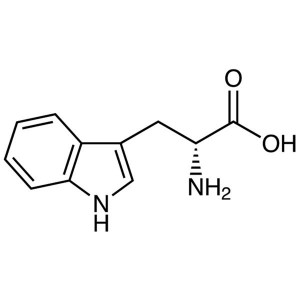
D-Tryptophan CAS 153-94-6 (H-D-Trp-OH) Assay 98...
-
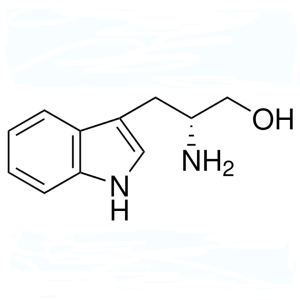
D-Tryptophanol CAS 52485-52-6 Assay ≥97.0% (HPLC)
-
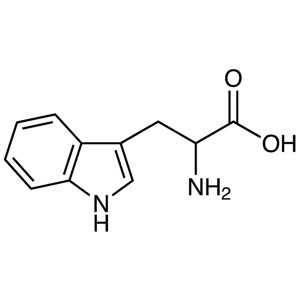
DL-Tryptophan CAS 54-12-6 (H-DL-Trp-OH) Assay >...
-
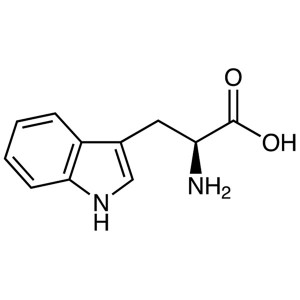
L-Tryptophan CAS 73-22-3 (H-Trp-OH) Assay 98.5~...
-
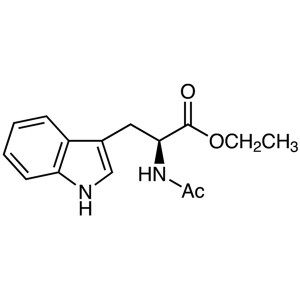
Ac-Trp-OEt CAS 2382-80-1 N-Acetyl-L-Tryptophan ...
-
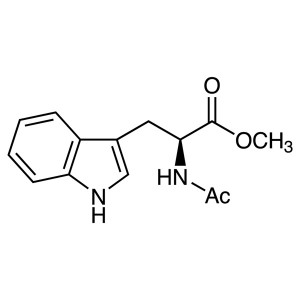
Ac-Trp-OMe Methyl N-Acetyl-L-Tryptophanate CAS ...
-
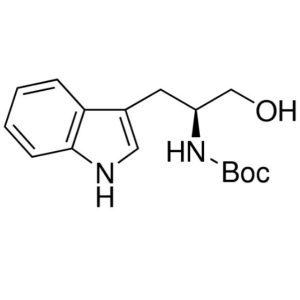
Boc-L-Tryptophanol CAS 82689-19-8 Boc-Trp-Ol Pu...
-
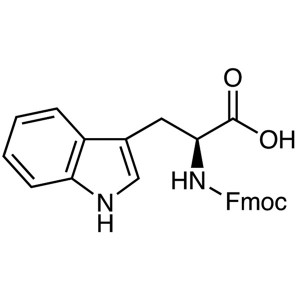
Fmoc-Trp-OH CAS 35737-15-6 Fmoc-L-Tryptophan Pu...
-
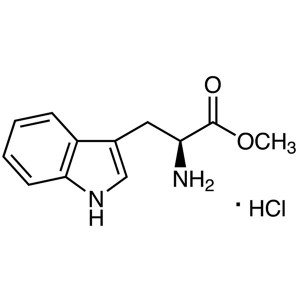
H-Trp-OMe·HCl CAS 7524-52-9 L-Tryptophan Methyl...
-
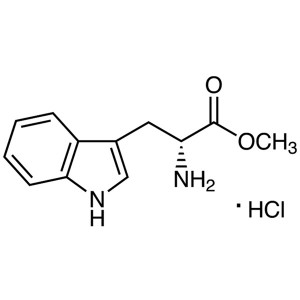
H-D-Trp-OMe·HCl CAS 14907-27-8 D-Tryptophan Met...
-
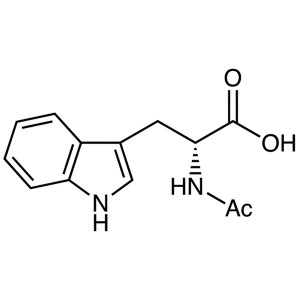
N-Acetyl-D-Tryptophan CAS 2280-01-5 (Ac-D-Trp-O...
-
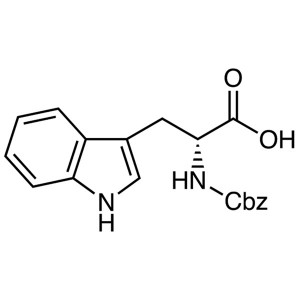
Z-D-Trp-OH CAS 2279-15-4 Nα-Cbz-D-Tryptophan Pu...
-
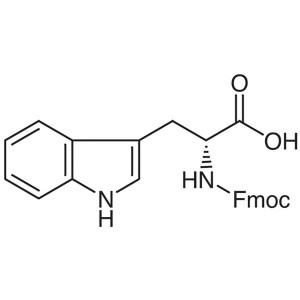
Fmoc-D-Trp-OH CAS 86123-11-7 Fmoc-D-Tryptophan ...
-
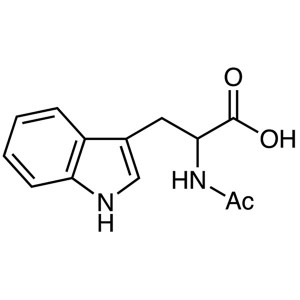
N-Acetyl-DL-Tryptophan CAS 87-32-1 (Ac-DL-Trp-O...
-
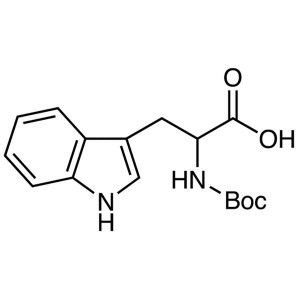
N-Boc-DL-Tryptophan CAS 112525-72-1 (Boc-DL-Trp...
-
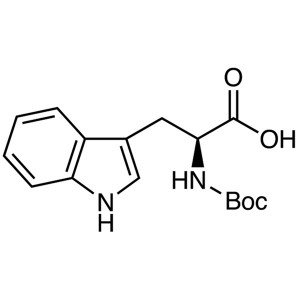
Boc-Trp-OH CAS 13139-14-5 Purity >99.0% (HPLC) ...

